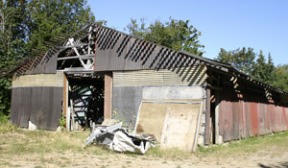But whether or not it’s worth saving, that’s another matter.
You wouldn’t necessarily entrust your life to it in a storm.
Maybe not even the lives of your pigs, these days at least.
So park officials don’t know what to do with a dilapidated old barn at Meigs Park, and are unsure whether it can be shored up before it crumbles into the earth.
“We’re not even sure we can pull it back up,†said Terry Lande, park district director. “We’re worried that if we pull it back up, there’s nothing to stop it from going back all the way the other way.â€
While often referred to as the “dairy barn,†the structure appears to have no actual historical value and no ties to the former Meigs farm, for which the property was named.
The structure was actually constructed as a shelter for pigs kept by the Sarin family, which owned the property in the 1970s, according to Gale Cool, another former owner.
The park off Highway 305 south of Koura Road was created in the early 1990s, when Cool purchased and consolidated several parcels of the historic farm.
He sold 67 acres to the Bainbridge Island Land Trust, and retained additional acreage for his own uses.
With the park property came the 3,000-square-foot barn structure, long used as storage for all manner of park detritus. Fencing, old paint, scrap lumber – even the bones of the Kiwanis Club’s old Santa House, which used to spring up on Winslow Way each holiday season – now moulder away within.
“And we’ve cleared it out a couple of times,†Lande said. “It was really bad, up to your eyeballs deep in stuff 18 months ago.â€
The building is perched on the eastern edge of the park, in an area that offers a picturesque view of the tree-covered valley rolling away from the highway.
Concerned for its structural integrity – the barn lists badly to one side, and affords visitors a nice view of the sky through parts of its roof – park officials recently put out a call on the district website asking for help with restoration.
An architect has already looked at the barn, with a visit by a structural engineer slated for later this summer.
Whether it’s worth saving, particularly if it is of no historical value, that has yet to be resolved.
A house that sits nearby is likely to be torn down; it was rejected for use as a park caretaker residence because of a poor foundation.
Lande said it may make more sense to knock the barn down and put up a new storage building in its place.
The district is already involved in the restoration of two historic buildings on park property.
The Depression-era scout cabin at Camp Yeomalt is the subject of ongoing preservation efforts, and was recently added to the city’s register of historic structures.
At Battle Point Park, volunteers are raising funds to turn the World War II-era transmitter building into a youth gymnastics facility.
Meigs, meanwhile, is something of a “forgotten†park among the district’s holdings and, with no amenities, attracts few visitors. The property boasts a complex wetland system of bogs and ponds, as well as old-growth spruce trees; no improvements have ever been made, as the park district concentrates on its other properties.
“It’s obvious that over the next few years, that park needs to be addressed,†Lande said. “Our goal is to make parks more accessible, whether that be boardwalks or trailways or whatever.â€


